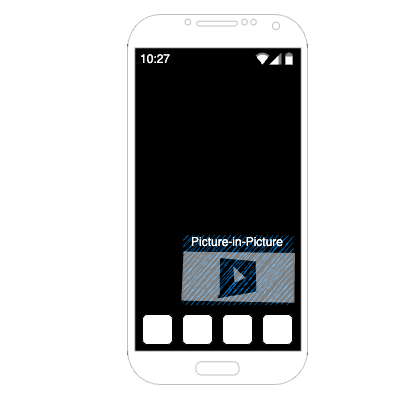How-to Add Picture in Picture
Enable picture-in-picture for Apple iOS devices
Picture-in-Picture (PiP) is compatible with iOS 16+. This feature allows you to support a floating video frame that persists even when the user sends the application to the background or switches to another application.

Refer to the Interactive Player sample application to learn more about implementing the code needed for PiP feature in a fully functioning iOS App.
Getting Started with iOS SDK
If you haven't already, begin by following the Getting Started tutorials to become familiar with the concepts to create an application that can publish and/or subscribe using the iOS SDK.
1. Setup AVPictureInPictureController
Once you have subscribed to a stream and have access to the video tracks available in the stream, follow the steps below to add Picture-In-Picture (PiP) Support.
1.1 Confirm that current OS/Device supports PiP
It is common practice to make sure that PiP is available on the current device given the wide range of applications and iOS versions currently in use. The isPictureInPictureSupported() method allows you to check before proceeding with the necessary changes.
For more information on the isPictureInPictureSupported() method, check out Apple's documentation.
guard AVPictureInPictureController.isPictureInPictureSupported() else { return }
1.2 Prepare the video view(MCSampleBufferVideoUIView) to show in PiP
Create a video view to show in PiP by passing in the renderer, where renderer is an instance of MCCMSampleBufferVideoRenderer.
let videoView = MCSampleBufferVideoUIView(frame: .zero, renderer: renderer)
videoView.translatesAutoresizingMaskIntoConstraints = false
videoView.layer.bounds = sourceView.bounds
Note: Only one renderer can be attached to a video track at a given time, so reuse the renderer(MCCMSampleBufferVideoRenderer) used to receive video in the app.
1.3 Add the video view to AVPictureInPictureVideoCallViewController
The AVPictureInPictureVideoCallViewController serves as a source for the AVPictureInPictureController (iOS Only). Create an instance AVPictureInPictureVideoCallViewController and add your video view as a subview.
MCSampleBufferVideoUIView has properties to query for video size changes and notifies frame changes via MCVideoViewDelegate. This can be used to set the preferredContentSize.
let pipVideoCallViewController = AVPictureInPictureVideoCallViewController()
pipVideoCallViewController.preferredContentSize = videoSize
pipVideoCallViewController.view.addSubview(videoView)
// Setup layout constraints.
NSLayoutConstraint.activate([
pipVideoCallViewController.view.topAnchor.constraint(equalTo: pipView.topAnchor),
pipVideoCallViewController.view.leadingAnchor.constraint(equalTo: pipView.leadingAnchor),
pipView.bottomAnchor.constraint(equalTo: pipVideoCallViewController.view.bottomAnchor),
pipView.trailingAnchor.constraint(equalTo: pipVideoCallViewController.view.trailingAnchor)
])
1.4 Create the PiP content source
Use the sourceView and the pipViewCallViewController to create a ContentSource for AVPictureInPictureController.
let pipContentSource = AVPictureInPictureController.ContentSource(activeVideoCallSourceView: sourceView, contentViewController: pipVideoCallViewController)
Note: Setting canStartPictureInPictureAutomaticallyFromInline ensures PiP playback is automatically started when your app moves to background.
2. Listen to Picture-in-Picture lifecycle events
Conform to the AVPictureInPictureControllerDelegate protocol to receive PiP lifecycle events and manage any activities that need to occur when starting and stopping PiP.
For more information on implementing the AVPictureInPictureControllerDelegate method, check out Apple's documentation.
func pictureInPictureControllerDidStartPictureInPicture(_ pictureInPictureController: AVPictureInPictureController) {
print("Started picture in picture")
}
func pictureInPictureControllerWillStartPictureInPicture(_ pictureInPictureController: AVPictureInPictureController) {
print("Will start picture in picture")
}
func pictureInPictureControllerWillStopPictureInPicture(_ pictureInPictureController: AVPictureInPictureController) {
print("Will stop picture in picture")
// Use the pictureInPictureControllerWillStopPictureInPicture delegate function to clean up the class instances created
pipController = nil
}
func pictureInPictureControllerDidStopPictureInPicture(_ pictureInPictureController: AVPictureInPictureController) {
print("Stopped picture in picture")
}
func pictureInPictureController(_ pictureInPictureController: AVPictureInPictureController, failedToStartPictureInPictureWithError error: Error) {
print("Failed to start picture in picture \(error.localizedDescription)")
}
Updated 7 months ago